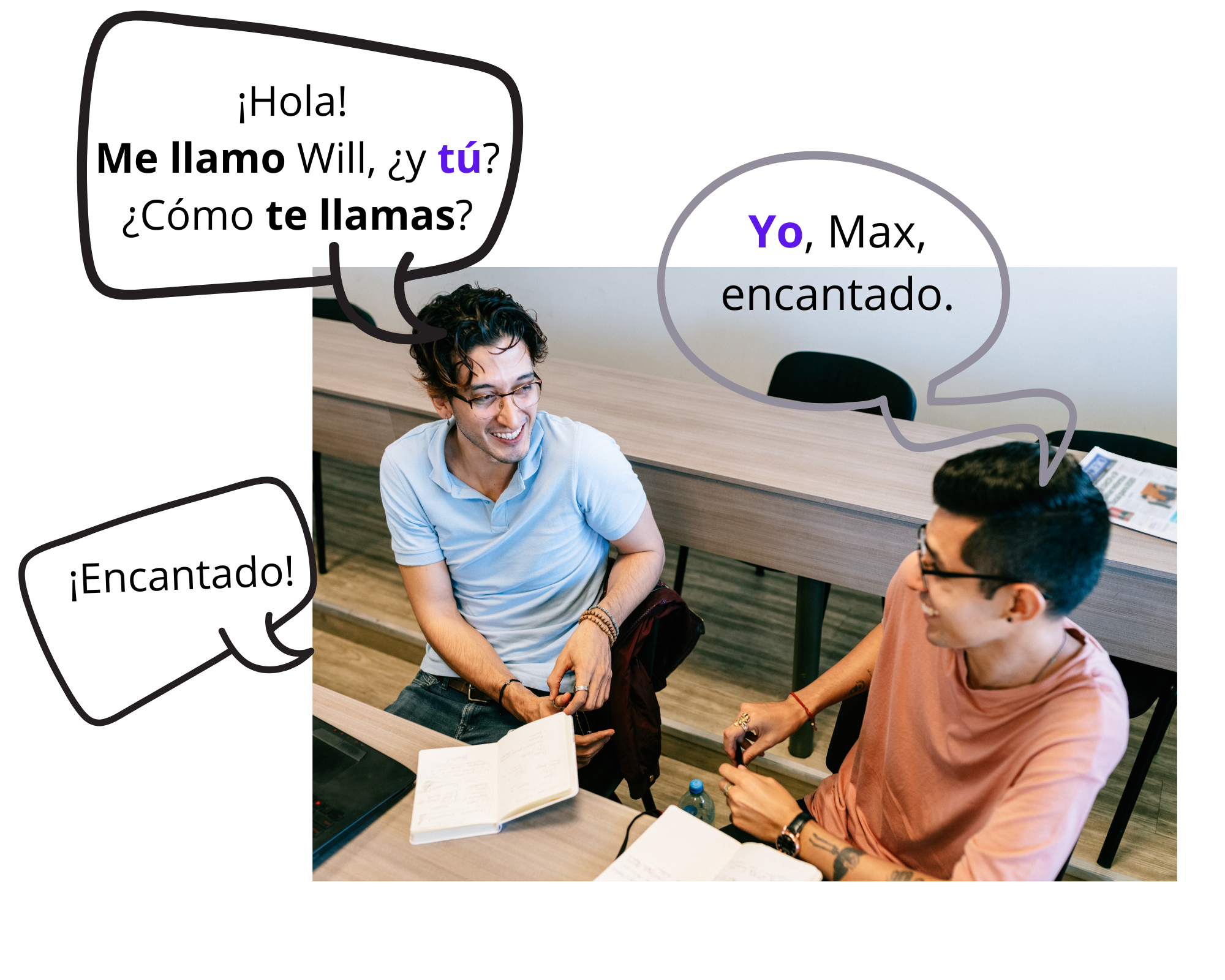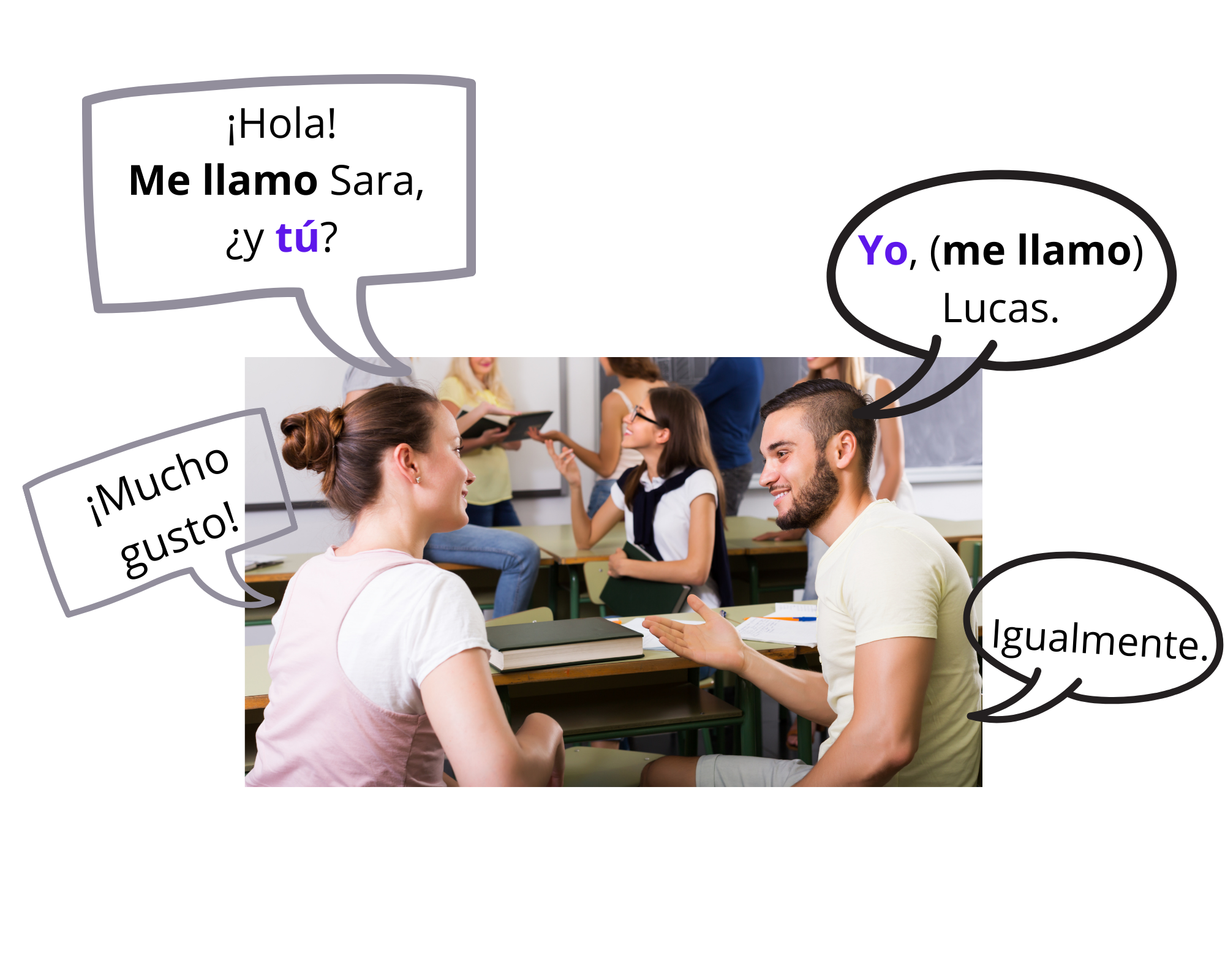3 Capítulo 1: Sección 2: Las presentaciones
Section Goal
In this section, students will learn how to introduce themselves, and others, to another person.
Diálogo 1
Diálogo 2

Diálogo 3

Video
Let’s have a look at this video from YouTube in which people respond to the question: ¿Cómo te llamas?
Analizamos
What do you notice about the three dialogues above? What about the video?
What are some possible ways of introducing yourself in Spanish?
Do you think ME LLAMO + NOMBRE and SOY + NOMBRE can be used interchangeably?
What about “tú” and “yo”? What do they mean?
Observamos
Let’s have a look at another exchange in this video from YouTube:
What do you notice about this exchange?
You may have noticed the use of the words ENCANTADO and ENCANTADA, which were also used in Diálogo 2 and Diálogo 3 above.
What do you think this word means?
Who uses each of these forms and why? Are there other words or expressions with the same meaning?
What else have you noticed?
LOS BESOS, of course—one or two kisses on the cheek, depending on the country you are from—are an important part of how we greet each other in Spanish-speaking contexts.
Of course, currently, physical contact has been reduced. In the tweet below from the Organización Mundial de la Salud (OMS), we see examples of alternative ways to avoid physical contact when greeting people.
Which one do you use the most?
Alternativas 👉🏽 en vez de darte la mano 🤝🏽, abrazo o "choca esos cinco" … durante COVID-19. ⤵️ pic.twitter.com/zSDEDo3zxS
— OPS/OMS (@opsoms) July 17, 2020
Exploramos más opciones
Conversamos
What do you think about the greeting practices in the Spanish-speaking world that we presented here?
Why do you think greetings and greeting practices are different in other cultures?
Do you like greeting practices from your culture? What about from other cultures?
What about greeting practices in other contexts? How do you greet family and friends? How do you greet teachers at university?[1]
Las Presentaciones
Listen to the video and respond to the following questions or phrases.
- ¿Cómo te llamas?
- ¿Cómo se llama? Me llamo
- Mi nombre es
- Soy
- Mucho gusto
- Encantad@
- Igualmente,
- Bienvenido/a/os/as
- Te presento a (nombre)
- Le presento a (nombre)
- Les presento a (nombre)
- ¿De dónde eres?
- Soy de (place)
- Señor
- Señora
- Señorita
- Profesor(a)
Actividad 9. Conversación
Instructions: After reading the conversation, practice your own conversation with a classmate, stating your name and where you are from and asking the same from your partner.
Contexto: In this conversation, two students strike up a conversation on a bench after the first day of class.
Flor: Hola, me llamo Flor.
Antonia: Hola, me llamo Antonia.
Flor: Mucho gusto.
Antonia: Igualmente.
Flor: ¿De dónde eres?
Antonia: Cuba. ¿Y tú?
Flor: Soy de Argentina.
Antonia: ¡Qué bien!
Flor: ¡Sí! Pues, perdóname, amiga, pero tengo que ir al trabajo.
Antonia: Vale, nos vemos mañana en clase.
Actividad 10. DNI—el Documento Nacional de Identidad
Spain, like many nations, requires all citizens over the age of 14 to carry a national ID card known as the DNI. It is used much like an American driver’s license for proof of identity.
Step 1. Fill in your personal information to create your own DNI.
| Documento Nacional de Identidad | ESPAÑA 11231234153 |
| Apellido | |
| Nombre | |
| Nacionalidad | |
| Fecha de nacimiento | |
| Firma |
Step 2. An interview. Use the following questions to interview three classmates about themselves, using a common question: ¿Cuál es? Listen to the audio to hear these questions asked.
- ¿Cuál es tu apellido?
- Mi apellido es
- ¿Cuál es tu nombre?
- Mi nombre es
- ¿Cuál es tu nacionalidad?
- Mi nacionalidad es
- ¿Cuál es tu fecha de nacimiento?
- Mi fecha de nacimiento es
Watch this video to hear responses:
¡A hablar!
Actividad 11. Amigos
Instructions: Introduce yourself to as many classmates as you can in the next five minutes. Learn their names and where they are from, write down what you learn about them, and then say goodbye.
| Nombre | Es de… |
Actividad 12. Las presentaciones
Instructions: Follow the steps below to practice introducing friends and meeting new people.
Step 1: Find a partner and introduce yourselves to one another.
Step 2: Then, find another set of partners. Greet them and introduce your partner to them. Your partner will then introduce you to the other set of partners. Now it is their turn to introduce each other to you and your partner.
Step 3: Elect a spokesperson for your group. When called upon, the spokesperson will introduce each member of the group to your instructor. Your instructor will respond to each member of the group with a pleasantry, and each member of the group will respond in kind.[2]
- All content from this section is a minor adaptation of "Juntx: I. Yo, tú, nosotrxs y ellxs: Nos Presentamos" by Adriana Diaz, The University of Queensland Australia, which is licensed under CC BY-NC-SA 4.0, unless otherwise noted ↵
- Las Presentaciones is a minor adaptation of “¡LIBRO LIBRE!: A free textbook for introductory Spanish” by Erin Huebener licensed CC BY-NC-SA 4.0. ↵


